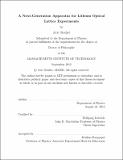| dc.contributor.advisor | Wolfgang Ketterle. | en_US |
| dc.contributor.author | Keshet, Aviv | en_US |
| dc.contributor.other | Massachusetts Institute of Technology. Department of Physics. | en_US |
| dc.date.accessioned | 2013-06-17T19:50:52Z | |
| dc.date.available | 2013-06-17T19:50:52Z | |
| dc.date.copyright | 2012 | en_US |
| dc.date.issued | 2013 | en_US |
| dc.identifier.uri | http://hdl.handle.net/1721.1/79254 | |
| dc.description | Thesis (Ph. D.)--Massachusetts Institute of Technology, Dept. of Physics, February 2013. | en_US |
| dc.description | Cataloged from PDF version of thesis. | en_US |
| dc.description | Includes bibliographical references (p. 167-173). | en_US |
| dc.description.abstract | Quantum simulation is emerging as an ambitious and active subfield of atomic physics. This thesis describes progress towards the goal of simulating condensed matter systems, in particular the physics of the Fermi-Hubbard model, using ultracold Lithium atoms in an optical lattice. A major goal of the quantum simulation program is to observe phase transitions of the Hubbard model, into Néel antiferromagnetic phases and d-wave superfluid phases. Phase transitions are generally accompanied by a change in an underlying correlation in a physical system. Such correlations may be most amenable to probing by looking at fluctuations in the system. Experimental techniques for probing density and magnetization fluctuations in a variety of atomic Fermi systems are developed. The suppression of density fluctuations (or atom "shot noise") in an ideal degenerate Fermi gas is observed by absorption imaging of time-of-flight expanded clouds. Intrap measurements of density and magnetization fluctuations are not easy to probe with absorption imaging, due to their extremely high attenuation. A method to probe these fluctuations based on speckle patterns, caused by fluctuations in the index of refraction for a detuned illumination beam, is developed and applied first to weakly interacting and then to strongly interacting in-trap gases. Fluctuation probes such as these will be a crucial tool in future quantum simulation of condensed matter systems. The quantum simulation experiments that we want to perform require a complex sequence of precisely timed computer controlled events. A distributed GUI-based control system designed with such experiments in mind, The Cicero Word Generator, is described. The system makes use of a client-server separation between a user interface for sequence design and a set of output hardware servers. Output hardware servers are designed to use standard National Instruments output cards, but the client-server nature allows this to be extended to other output hardware. Output sequences running on multiple servers and output cards can be synchronized using a shared clock. By using an FPGA-generated variable frequency clock, redundant buffers can be dramatically shortened, and a time resolution of 100ns achieved over effectively arbitrary sequence lengths. Experimental set-ups for producing, manipulating, and probing ultracold atomic gases can be quite complicated. To move forward with a quantum simulation program, it is necessary to have an apparatus that operates with a reliability that is not easily achieved in the face of this complexity. The design of a new apparatus is discussed. This Sodium-Lithium ultracold gas production machine has been engineered to incorporate as much experimental experience as possible to enhance its reliability. Particular attention has been paid to maximizing optical access and the utilization of this optical access, controlling the ambient temperature of the experiment, achieving a high vacuum, and simplifying subsystems where possible. The apparatus is now on the verge of producing degenerate gases, and should serve as a stable platform on which to perform future lattice quantum simulation experiments. | en_US |
| dc.description.statementofresponsibility | by Aviv Keshet. | en_US |
| dc.format.extent | 173 p. | en_US |
| dc.language.iso | eng | en_US |
| dc.publisher | Massachusetts Institute of Technology | en_US |
| dc.rights | M.I.T. theses are protected by
copyright. They may be viewed from this source for any purpose, but
reproduction or distribution in any format is prohibited without written
permission. See provided URL for inquiries about permission. | en_US |
| dc.rights.uri | http://dspace.mit.edu/handle/1721.1/7582 | en_US |
| dc.subject | Physics. | en_US |
| dc.title | A next-generation apparatus for lithium optical lattice experiments | en_US |
| dc.type | Thesis | en_US |
| dc.description.degree | Ph.D. | en_US |
| dc.contributor.department | Massachusetts Institute of Technology. Department of Physics | |
| dc.identifier.oclc | 846488228 | en_US |
